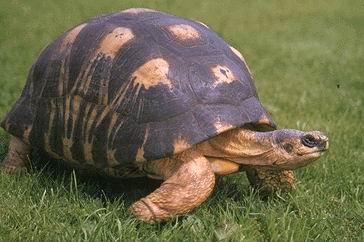Radiated Tortoise
Sokake Scientific Name: Geochelone radiata
Sat, 23rd November, 2024 - 11:13 am GMT
Sponsor Ads:

Alternative Name
Sokake Scientific Name: Geochelone radiataBasic Info
The Radiated Tortoise has a high-domed carapace, which is brilliantly marked. Its name comes from the striking yellow lines that radiate from the center of each dark plate on the shell. This tortoise's pattern is much more detailed and intricate than those found on other tortoises. They have yellowish feet, tails, and heads. Most will also have a black patch on the tops of their heads. Males can be distinguished from females by their longer tails. They are moderately sized tortoises with carapaces measuring up to 16 inches. They can weight up to 35 pounds.
Health
The Radiated Tortoise's diet should be high in fiber. Most of the diet should, ideally, consist of grasses and dark leafy green vegetables such as collard and turnip greens. In the wild, succulents make up part of their diet, so they can be offered prickly pear pads, fruit, and flowers. They can also be given small amounts of other vegetables and some fruit. Carrots, apples, sweet potatoes, tomatoes, cucumbers, melons, and alfalfa sprouts can all make nice treats. These tortoises do not do well in cold weather and should not be kept in areas where temperatures fall below 60 degrees Fahrenheit at night. Breeding Breeding should not be attempted until males and females are slightly larger than a foot. Males initiate breeding with a courtship ritual that consists of circling the female, sniffing her legs and bobbing his head. If the male begins trying to lift the female, do not worry, as this is quite normal. This behavior may be done to attempt to prevent her from moving away. The male will mount her from behind once she stops moving. After mating, the female will dig a nest and deposit anywhere from 3 to 12 eggs. In captivity, it can take anywhere from 145 to 231 days until hatching.Habitat
The Radiated Tortoise's native habitat is dry areas of thorn brushes, brush, and woodlandsBehavior
The Radiated Tortoise, also known as the Sokake, is incredibly beautiful. Some maintain that it is the most beautiful of all the tortoises. It is a rare species, and those who are lucky enough to own them have a wonderful addition to their collections. . They are herbivores, and in the wild their diet consists of succulents and grasses. In captivity, they are reported to have a very strong attraction to red foods and do well on a variety of vegetables and fruits. These tortoises are very rare and considered highly endangered in the wild. They are also not common in captivity. Captive breeding programs are vital to the continued survival of this species, and luckily captive breeding attempts have been relatively successful. These tortoises are relatively rare in captivity and are quite expensive.Origin
MadagascarHistory
The Radiated Tortoise originates in Madagascar in the far south and southwestern regions of the island.Common Foods
ost of the diet should, ideally, consist of grasses and dark leafy green vegetables such as collard and turnip greens. In the wild, succulents make up part of their diet, so they can be offered prickly pear pads, fruit, and flowers. They can also be givenSponsor Ads:
It is only in Aesop's fables that an elephant takes advice from a mouse. -- Unknown
Radiated Tortoise
Coded by: BGID® | ALL RIGHTS RESERVED Copyright © 2000-2024
Disclaimer | Privacy | Report Errors / Contact | Credits



 Beware the new Naval power, they are planning to come on stream with big naval might to match their ground forces. Chinese Aircraft Carrier - Chinese Navy
Beware the new Naval power, they are planning to come on stream with big naval might to match their ground forces. Chinese Aircraft Carrier - Chinese Navy  versus
versus 
 versus
versus  This Thread is about the North Korean Military itself - the kind of army, navy, and air force they have.
This Thread is about the North Korean Military itself - the kind of army, navy, and air force they have. 
 versus
versus  versus
versus 
 versus
versus  versus
versus